Filter by
You must be a CTBUH Member to view this resource.
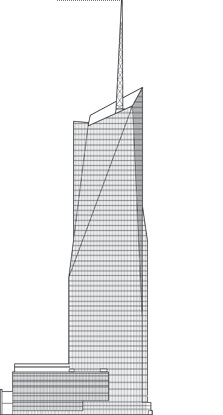
Bank of America Tower
One Bryant Park
Building
Completed
2009
Office
Concrete-Steel Composite
LEED Platinum
365.8 m / 1,200 ft
55
3
52
8.1 m/s
195,095 m² / 2,099,985 ft²
You must be a CTBUH Member to view this resource.
You must be a CTBUH Member to view this resource.
Proposed
Construction Start
Completed
Usually takes on the balance of the architectural effort not executed by the "Design Architect," typically responsible for the construction documents, conforming to local codes, etc. May often be referred to as "Executive," "Associate," or "Local" Architect, however, for consistency CTBUH uses the term "Architect of Record" exclusively.
The Design Engineer is usually involved in the front end design, typically taking the leadership role in the Schematic Design and Design Development, and then a monitoring role through the CD and CA phases.
The Design Engineer is usually involved in the front end design, typically taking the leadership role in the Schematic Design and Design Development, and then a monitoring role through the CD and CA phases.
The main contractor is the supervisory contractor of all construction work on a project, management of sub-contractors and vendors, etc. May be referred to as "Construction Manager," however, for consistency CTBUH uses the term "Main Contractor" exclusively.
Other Consultant refers to other organizations which provided significant consultation services for a building project (e.g. wind consultants, environmental consultants, fire and life safety consultants, etc).
These are firms that consult on the design of a building's façade. May often be referred to as "Cladding," "Envelope," "Exterior Wall," or "Curtain Wall" Consultant, however, for consistency CTBUH uses the term "Façade Consultant" exclusively.
Material Supplier refers to organizations which supplied significant systems/materials for a building project (e.g. elevator suppliers, facade suppliers, etc).
You must be a CTBUH Member to view this resource.
Usually involved in the front end design, with a "typical" condition being that of a leadership role through either Schematic Design or Design Development, and then a monitoring role through the CD and CA phases.
Usually takes on the balance of the architectural effort not executed by the "Design Architect," typically responsible for the construction documents, conforming to local codes, etc. May often be referred to as "Executive," "Associate," or "Local" Architect, however, for consistency CTBUH uses the term "Architect of Record" exclusively.
The Design Engineer is usually involved in the front end design, typically taking the leadership role in the Schematic Design and Design Development, and then a monitoring role through the CD and CA phases.
The Design Engineer is usually involved in the front end design, typically taking the leadership role in the Schematic Design and Design Development, and then a monitoring role through the CD and CA phases.
The main contractor is the supervisory contractor of all construction work on a project, management of sub-contractors and vendors, etc. May be referred to as "Construction Manager," however, for consistency CTBUH uses the term "Main Contractor" exclusively.
Other Consultant refers to other organizations which provided significant consultation services for a building project (e.g. wind consultants, environmental consultants, fire and life safety consultants, etc).
These are firms that consult on the design of a building's façade. May often be referred to as "Cladding," "Envelope," "Exterior Wall," or "Curtain Wall" Consultant, however, for consistency CTBUH uses the term "Façade Consultant" exclusively.
Material Supplier refers to organizations which supplied significant systems/materials for a building project (e.g. elevator suppliers, facade suppliers, etc).
2010 CTBUH Awards
13 October 2016 - CTBUH Research
28 October 2015 - Event
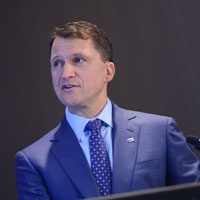
26 October 2015 | New York City
Tall Buildings in urban landscapes present a unique challenge in the field of sustainable building. These structures tend to attract a tenant base of dynamic...

17 September 2021
Will Miranda & Daniel Safarik, CTBUH
Some 97 cities worldwide, including most of the world’s megacities with a population of 10 million or more, have signed onto the C40 Cities Climate...
The Bank of America Tower at One Bryant Park was designed to set a new standard in high-performance buildings, for both the office workers who occupy the tower and for a city and country that are awakening to the modern imperative of sustainability. Drawing on concepts of biophilia—or humans’ innate need for connection to the natural environment—the vision at the occupant scale was to create the highest quality modern workplace by emphasizing daylight, fresh air, and an intrinsic connection to the outdoors. At the urban scale, the tower addresses its local environment as well as the context of midtown Manhattan, to which it adds an expressive new silhouette on an already-iconic skyline.
The building responds to the dense urban context by weaving into the existing grid at street level, yet challenging the boundaries of public and private space with a highly transparent corner entry. As it rises, the tower shears into two offset halves, increasing the verticality of its proportions as well as the surface area exposed to daylight. Mass is sliced from these two rectilinear volumes, producing angular facets that open up light and oblique views beyond the typical limits of urban geometry. The crystalline form—inspired by the legacy of the 1853 Crystal Palace, which once stood adjacent in Bryant Park, and by a quartz crystal from the client’s collection—suggests an appropriate natural analogue, both organic and urban in nature. With its crisp, folded façade, the tower changes with the sun and sky; its southeast exposure, a deep double wall, orients the building in its full height toward Bryant Park, its namesake and the most intensively-used open space in the US.
With the Bank of America as its primary tenant, occupying six trading floors and 75% of its interior, the tower signals a significant shift in corporate America and in the real estate industry, acknowledging the higher value of healthy, productive workplaces. One Bryant Park’s most lasting achievement is to merge the ethics of the green building movement with a twenty-first century aesthetic of transparency and re-connection.
Bank of America Tower is the first commercial high-rise to earn LEED Platinum certification from the US Green Building Council. The building’s advanced technologies include a clean-burning, on-site, 5.0 MW cogeneration plant, which provides approximately 65% of the building’s annual electricity requirements and lowers daytime peak demand by 30%. A thermal storage system further helps reduce peak load on the city’s over-taxed electrical grid by producing ice at night, melted during the day to provide cooling. Nearly all of the 1.2m (4ft) of annual rain and snow that fall on the site is captured and re-used as gray water to flush toilets and supply the cooling towers. These strategies, along with waterless urinals and low-flow fixtures, save approximately 7.7 million gallons of potable water per year.
Recycling was a prominent factor throughout the building’s construction, with 91% of construction and demolition waste diverted from landfill. Materials include steel made from 75% (minimum) recycled content and concrete made from cement containing 45% recycled content (blast furnace slag). To protect indoor air quality as well as natural resources, interior materials are low-VOC, sustainably harvested, manufactured locally, and/or recycled wherever possible.
The building’s exceptionally high indoor environmental quality results from hospital-grade, 95% filtered air; abundant natural daylight and 2.9m (9.5ft) ceilings; an under-floor ventilation system with individually-controlled floor diffusers; round-the-clock air quality monitoring; and views through a clear, floor-to-ceiling glass curtain wall. This high-performance curtain wall minimizes solar heat gain through low-E glass and heat-reflecting ceramic frit; it also has allowed the Bank of America Tower to reduce artificial lighting with an automated daylight dimming system, reducing lighting and cooling energy by up to 10%.
On an urban level, the project also represents the culmination of the developer’s multigenerational efforts to revitalize the Times Square area, and gives back to the city with a street-level Urban Garden Room, a mid-block pedestrian passage/performance space, and the first “green” Broadway theater, the LEED Gold Stephen Sondheim Theater.
In an era of heightened security, a central challenge of the project was balancing the complexities of program and scale with high-performance architecture and urban design. In its layered connection to the ground plane, Bank of America Tower resolves this question with a progression of public and private spaces—from Bryant Park to the Urban Garden Room to the semi-public lobby. As a total response to the urban environment, the building’s restorative connections therefore work on many levels, from green roofs and views of the park to more subtle and expressive elements. A highly integrated approach to architecture and engineering ensured a close relationship between form and function. Bridging contexts as vastly different as Times Square and Bryant Park, the project makes a highly visible statement on urban stewardship and global citizenship for the 21st century.
2010 CTBUH Awards

26 October 2015 | New York City
Tall Buildings in urban landscapes present a unique challenge in the field of sustainable building. These structures tend to attract a tenant base of dynamic...

26 October 2015 | New York City
New York’s most iconic buildings, the early 20th-Century high rises, were designed as aspirational symbols of urban life with carefully sculpted forms that mediate between...

06 November 2014 | New York City
Douglas Durst is the chairman and a member of the third generation to lead The Durst Organization, one of New York’s oldest and most respected...

21 October 2010 | New York City
Lisa Shpritz, Senior Vice President, Bank of America, and Richard Cook, Partner, Cook + Fox Architects. Bank of America Tower has produced a high level...

21 October 2010 | New York City
The 9th Annual Awards Ceremony & Dinner was held in Mies van der Rohe’s iconic Crown Hall, on the Illinois Institute of Technology campus, Chicago....

21 October 2010 | New York City
Richard Cook of Cook + Fox Architects is interviewed by Jeff Herzer during the 2010 CTBUH Awards Symposium at the Illinois Institute of Technology, Chicago....

17 September 2021
Will Miranda & Daniel Safarik, CTBUH
Some 97 cities worldwide, including most of the world’s megacities with a population of 10 million or more, have signed onto the C40 Cities Climate...
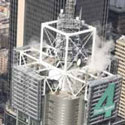
26 October 2015
Alexander Durst, The Durst Organization
Tall Buildings in urban landscapes present a unique challenge in the field of sustainable building. These structures tend to attract a tenant base of dynamic...
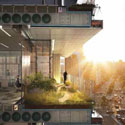
26 October 2015
Rick Cook & Jared Gilbert, COOKFOX Architects
New York’s most iconic buildings, the early 20th-Century high rises, were designed as aspirational symbols of urban life with carefully sculpted forms that mediate between...
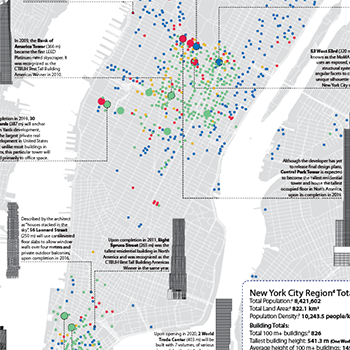
22 October 2015
CTBUH Research
A timeline of skyscraper completions in New York uncannily resembles the boom and bust cycles of the United States in the 20th and early 21st...

01 August 2011
Nathaniel Hollister, Jan Klerks & Antony Wood, CTBUH
New York’s dramatic skyline, over a century in the making, has for years been the envy of cities around the world. From the very birth...

31 December 2009
CTBUH Research
Trump International Hotel & Tower named tallest building completed in 2009; Successful year for the American high-rise. Over half of all buildings 200m or taller...

03 March 2008
Robert F. Fox, Jr., Cook + Fox Architects
Through four case studies – 4 Times Square, the Battery Park City Guidelines, The Bank of America Tower at One Bryant Park, and PlaNYC2030 –...
13 October 2016
The Council is pleased to announce the Top Company Rankings for numerous disciplines as derived from the list of projects appearing in 100 of the World’s Tallest Buildings.
28 October 2015
CTBUH 2015 delegates toured 4 Times Square and Bank of America Tower which are a fantastic look at two generations of towers that focus on sustainability and quality of environment.
9 July 2015
At the Bank of America Tower in New York City, more than 200 professionals attended “VIA 57 West: Challenging Building Form and Urban Development in Manhattan.”
29 January 2015
The new CTBUH Urban Habitat / Urban Design Committee organized a highly successful Winter Spaces Walking Tour in seven cities around the world.
21 November 2014
Plans for the 2015 Conference in New York are now well underway, beginning with an initial meeting of the Steering Committee at the Bank of America Tower Nov. 18.
Subscribe below to receive periodic updates from CTBUH on the latest Tall Building and Urban news and CTBUH initiatives, including our monthly newsletter. Fields with a red asterisk (*) next to them are required.
View our privacy policy